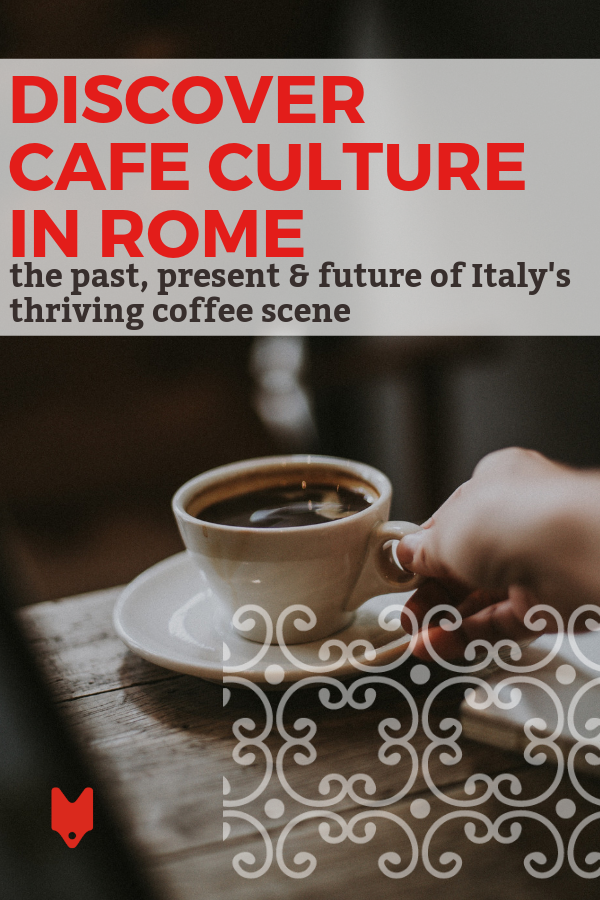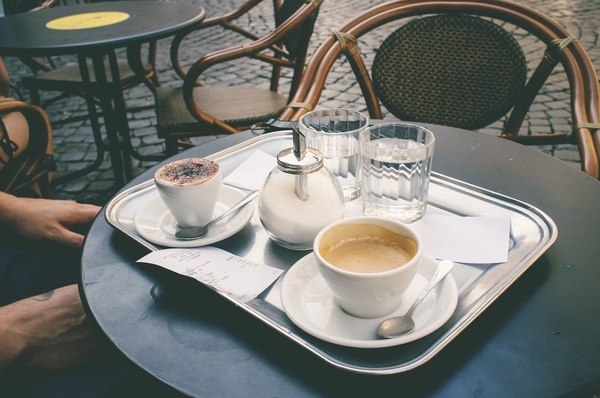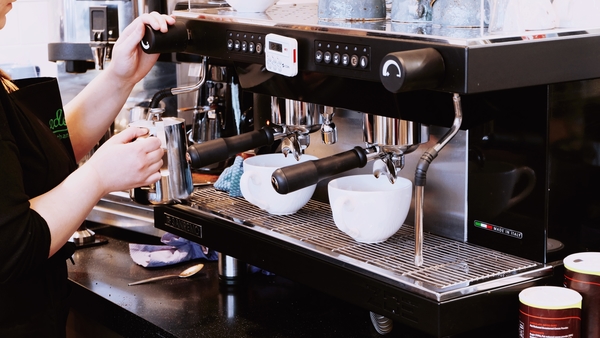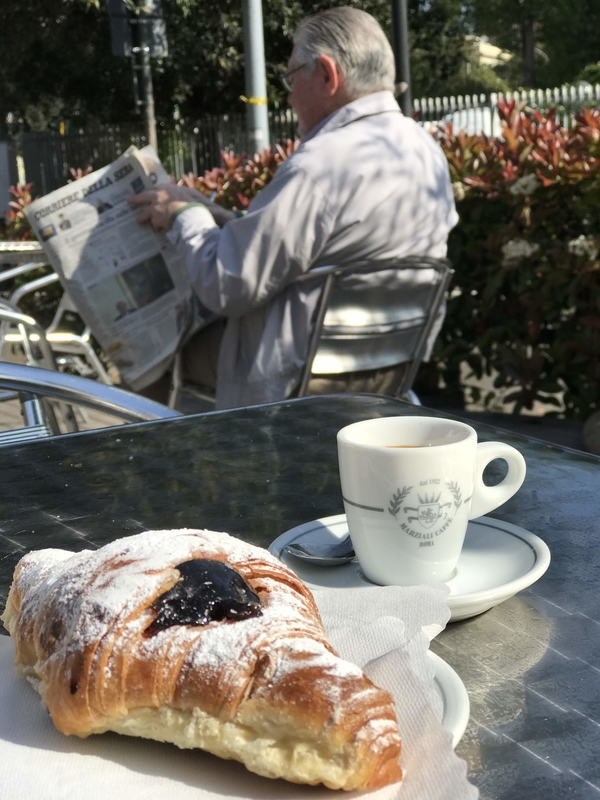When you think of Italy, we bet you think of pizza, pasta and coffee.
But let’s focus on the third thing for now. There’s a good reason why Italy is synonymous with charming sidewalk cafes and flavorful coffee—in fact, it would practically be a sin to come here and not indulge in an espresso, cappuccino (just not after breakfast!) or whatever your preferred form of caffeine may be at one of said Italian cafes.
Ready to learn more about the drink that shaped Roman culture as we know it today? Read on to learn how Italian coffee came to be, and how Rome’s cafe culture has changed over the years.

How coffee came to Rome
Indeed, the little brown bean, prized for its stimulant qualities, has a long history in the peninsula. It first arrived in Italy around 1570 in the port city of Venice, imported along trade routes from Turkey. First available only through pharmacies, its fame and its presence soon spread further afield.
It made it to Rome, much to the disdain of priests and politicians alike who baulked at its Islamic origins. Declaring it the “drink of the devil,” they appealed to their ruler, Pope Clement VIII (1536–1605) to ban it altogether. The story goes that the Pope decided to test it first and was so impressed by its flavor that he refused their request.
With papal approval, coffee was unstoppable.
RELATED: The 6 Best Places for Coffee in Rome

A brief history of Roman cafes
By the 18th century, coffee had moved out of the pharmacy and had taken up residence in establishments specializing in the beverage. These coffee houses became the center of the intellectual and artistic world of the 1700s.
The coffee house opened in 1760 by a certain Greek gentleman in Via dei Condotti became a regular hangout for writers and composers such as Byron, Keats, Ibsen, Mendelssohn, Wagner, and even Hans Christian Andersen. The Antico Caffè Greco is still open and you can relive the splendor of this bygone age at a price.

Over the next couple of hundred years, many torrefazioni, shops that roasted and ground coffee for off-site sale, added their own bars to their workshops. This is how the famous Bar Sant’Eustachio started in the area near the Pantheon. Staying true to their origins, you can still buy their blends of coffee to take home with you.
By the 1920s and 30s, cafes became associated with modern, gracious living in Rome. The Sciascia Caffè, which opened in 1919 but moved to its current location in 1937, still boasts its elegant 30s interiors which would have been the height of modernity when it opened.
It was at this time that Achille Gaggia, a Milanese barman, started working on his dream of the ultimate coffee machine, which he finally put into mass production in 1948. With it was born the style of coffee known within Italy simply as caffè but to the rest of the world as espresso.
Gaggia’s beautiful shiny machines, which could produce a shot of perfect coffee in seconds, became very fashionable in Rome’s post-war dolce vita era. They added to the elegance of coffee bars, which often became used as film sets. Who can forget Audrey Hepburn and Gregory Peck sipping coffee outside the Pantheon in “Roman Holiday” (1953)? Many of them also feature in the films of Federico Fellini. The director used to drink his coffee at Canova in Piazza del Popolo, which today has a gallery dedicated to his work.

Rome’s cafe culture today
Mass production of espresso machines by Gaggia and rival companies meant that Rome’s local bars could buy them and produce a high-quality product at a low cost. This had the effect of democratizing coffee. Now it’s the drink of the people: fast, cheap, and perfect for a quick breakfast or morning break. The old elegant cafes of yesteryear, where you can enjoy a coffee over an intellectual debate or sip your cappuccino like a 30s film star, still remain. However, most Romans now have their coffee in a bar.
What’s also changed is the kind of coffee. With the invention of the espresso machine, which has a nifty gadget for steaming milk, a whole cast of other coffees became possible: espresso was center stage but it was soon joined by macchiato (“stained” with a little milk), cappuccino (which needs no explanation), corretto (with a shot of alcohol), marocchino (a coffee and chocolate hybrid), and many, many more. Almost every person has their own variation.
Read more: The Complete Guide to Ordering Coffee in Italy
Although in the past, people would meet for coffee mid-morning or in the afternoon, the focus has now shifted to the early morning. Early in the morning, bars are full as people have a quick breakfast—or second breakfast—of coffee and cornetto (croissant) on their way to work. Likewise, they often drop in throughout the day for a quick caffeine fix. If you have a meeting in a Roman office, instead of fixing you a coffee they might take you down to the local bar for one. Have your hair cut, and the barber might pop to the bar next door to get you a complimentary espresso.

Even in these days of capsule coffee, most Romans prefer to visit a bar where they will drink their coffee in a few minutes standing at the bar (al banco) at a cost of less than €1. They will drink it from a small ceramic cup (tazzina) or a small glass (al vetro) according to personal preference. However, there’s one thing that they will never do: order a cappuccino, which is strictly considered a breakfast drink, after 11 a.m.
Recently a few American-style coffee shops have opened in Rome, mostly catering to expats, tourists and students. So strong is the traditional Italian coffee culture, however, that they have never really caught on. In 2019 Starbucks is due to open their first shop in Rome. The location they have chosen, close to the Vatican Museums, suggests who they are expecting their customers to be.
Roman bars are great places to find a quiet corner and people watch. Visiting one will give you a real taste of city life. The clientele and ambience may have changed over the years, but the Roman love of coffee has not.
Ready to experience Rome’s cafe culture for yourself? Join us on our Testaccio Neighborhood Food & Market Tour, where we’ll start the day with a traditional breakfast of coffee and pastries at one of Rome’s most emblematic cafes. From there, you’ll continue exploring one of the Eternal City’s last remaining truly authentic neighborhoods, where you’ll join the locals as they eat, shop, and go about their daily lives. Come hungry!